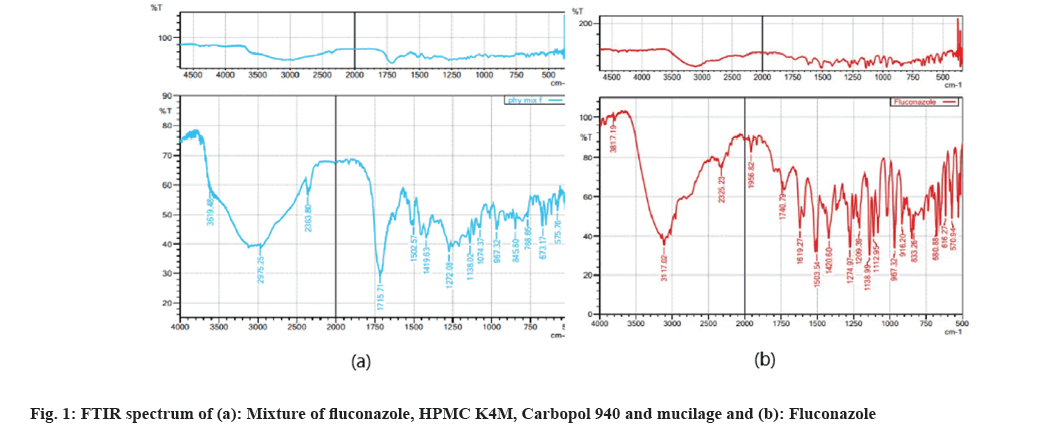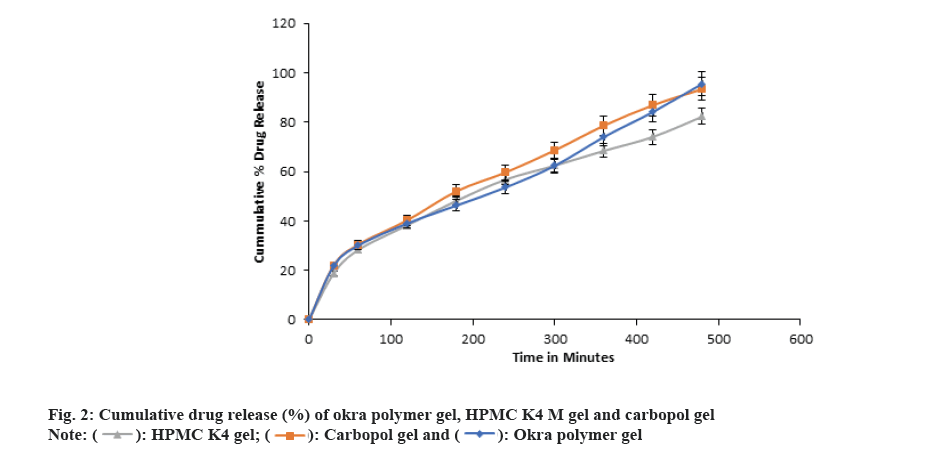- *Corresponding Author:
- Vidya Sabale
Department of Pharmaceutics, Dadasaheb Balpande College of Pharmacy, Nagpur, Maharashtra 440037, India
E-mail: vidyasabale@yahoo.co.in
| Date of Received | 22 December 2021 |
| Date of Revision | 05 November 2022 |
| Date of Acceptance | 04 September 2023 |
| Indian J Pharm Sci 2023;85(5):1530-1533 |
This is an open access article distributed under the terms of the Creative Commons Attribution-NonCommercial-ShareAlike 3.0 License, which allows others to remix, tweak, and build upon the work non-commercially, as long as the author is credited and the new creations are licensed under the identical terms
Abstract
The objective of the present study was to extract mucilage from okra and evaluate it as a gelling agent in the vaginal gel. The okra mucilage was extracted following the established methods. The percentage yield of okra mucilage was found to be 8.0 % w/w. The Fluconazole antifungal vaginal gel was formulated using the okra mucilage as gelling agent and evaluated for compatibility study, viscosity, pH, spreadability and diffusion study. The effect of the mucilage as the gelling agent was compared with the commonly used synthetic polymers such as carbopol 940 and hydroxypropyl methyl cellulose at the concentration of 0.5 %, 1 % and 1.5 % w/w. The result of the study showed that the okra mucilage was comparable to polymer carbopol 940 and hydroxypropyl methyl cellulose K4M as gelling agent. Thus, okra mucilage (1.5 %) has the potential for being substituted as gelling agent in place of conventional gelling agent.
Keywords
Okra, gelling agent, vaginal gel, diffusion, viscosity
Gels are semisolid systems containing either suspensions composed of small inorganic particles or large organic molecules interpenetrated by a liquid[1]. Gelling agent polymers possess the property of gelation that is useful in the formulation of stable systems by reducing interfacial and surface tension thereby increasing the viscosity of the liquid phase[2]. Mucilages are produced intracellularly, as a result of metabolism and may act as storage matter. These are polysaccharide macromolecules that dissolve more or less upon contact with water and form colloidal solutions[3]. Vaginal infection is the most common disease in our day-to-day life and includes bacterial vaginosis, candida infections, trichomoniasis, etc[4]. Women are more susceptible for causing infection because of substantial mucosal exposure to seminal fluids, pH change, etc[5]. Treatment of these infections is mostly done with antifungal agents as most of the infections are caused due to fungi and can be classified as systemic and topical infections. Fluconazole is a synthetic antifungal agent belonging to group of triazole and commonly used antifungal agent[6].
Among the various drug delivery systems, vaginal route offers many advantages due to its large permeation area, rich vascularisation, avoidance of first pass metabolism, reduction in the incidence and severity of gastrointestinal side effects, a decrease in hepatic side effects and relatively low enzymatic activity[5,7]. External application of gel at skin offers certain advantages like quick release of drug directly to the site of action, independency of water solubility of drug as compared to creams and ointments, better patient compliance, less interaction with food and drugs and avoiding first pass effect[8]. The large numbers of synthetic and natural polymers have been used to achieve mucoadhesion in pharmaceutical formulations. The use of natural polymers as excipients in pharmaceutical sectors is increasing day by over semi synthetic or synthetic excipients because of their easy availability, safety, non-irritancy and cost effectiveness[9]. Okra mucilage is natural plant polysaccharide from the fruits of Abelmoschus esculentus (Family: Malvaceae). This polysaccharide is non-toxic, as it obtained from an edible source[10]. It is an acidic polysaccharide consisting of galactose, rhamnose and galacturonic acid[11]. Okra mucilage makes viscous solution in water owing to its 1.7 million molecular weight glycoproteins[12]. It has excellent protective colloid properties. Its vegetable derivation and rheological properties make it ideal for as combination of flavouring agent[13]. Okra mucilage has studied for its suspending, disintegrant property, floating property as well as better sustained release of the drug[14,15]. But its gelling property is not reported. This study is carried out to determine its potential utility as mucoadhesive gelling agent. The materials used for the present study were fluconazole, Hydroxypropylmethyl Cellulose (HPMC) K4M, carbomer 940, glycerin, propylene glycol, methyl paraben, propyl paraben, sodium dihydrogen phosphate, disodium hydrogen phosphate, methanol, acetic acid, Triethanolamine (TEA) and ethanol. Desiccator, Fourier Transform Infrared (FTIR) spectrophotometer, spreadability test apparatus, Brookfield viscometer, ultraviolet-visible spectrophotometer and Franz diffusion cell were employed for the present study. Okra fruits were purchased from the local market, Nagpur, Maharashtra. The plant material was identified and authenticated by Botanist, Department of Botany, R. T. M. Nagpur University, Nagpur. The specimen number given to the authenticated herbarium sheet was 10272. Mucilage was isolated from okra fruits using aqueous extraction method[3]. The isolated mucilage was characterized for swelling index, pH, loss on drying, solubility and viscosity[16]. Compatibility study was carried out using FTIR (Shimadzu Corporation Kyoto, Japan). Antifungal gel was formulated using Fluconazole (1 % w/w) which was dissolved in a hot mixture of propylene glycol (20 % w/w) and glycerin (10 % w/w) as moistening agent. Carbopol 940, HPMC K4M gel was prepared by dispersing the calculated amount of polymer (1.5 %) in calculated amount of warm water with constant stirring using magnetic stirrer at a moderate speed. Mucilage was also soaked in water with stirring at moderate speed. Then the previous mixture containing the drug was added to this. The pH of the carbopol gel was adjusted using TEA as 4.5[6]. The gel formulations were prepared (Table 1) using three different concentrations of okra mucilage i.e., 0.5 %, 1 % and 1.5 % and compared with the Carbopol 940 and HPMC K4M gel.
| Ingredients (% w/w) | Batches | ||||||||
|---|---|---|---|---|---|---|---|---|---|
| F1 | F2 | F3 | F4 | F5 | F6 | F7 | F8 | F9 | |
| Fluconazole | 1 | 1 | 1 | 1 | 1 | 1 | 1 | 1 | 1 |
| Carbopol 940 | 0.5 | 1 | 1.5 | - | - | - | - | - | - |
| HPMC K4M | - | - | - | 0.5 | 1 | 1.5 | - | - | - |
| Okra mucilage | - | - | - | - | - | - | 0.5 | 1 | 1.5 |
| Glycerin | 10 | 10 | 10 | 10 | 10 | 10 | 10 | 10 | 10 |
| Propylene glycol | 20 | 20 | 20 | 20 | 20 | 20 | 20 | 20 | 20 |
| Methyl paraben | 0.03 | 0.03 | 0.03 | 0.03 | 0.03 | 0.03 | 0.03 | 0.03 | 0.03 |
| Propyl paraben | 0.01 | 0.01 | 0.01 | 0.01 | 0.01 | 0.01 | 0.01 | 0.01 | 0.01 |
| Purified water (q. s.) | 100 | 100 | 100 | 100 | 100 | 100 | 100 | 100 | 100 |
Table 1: Formulation of Gel Containing OKRA MUCILAGE, CARBOPOL 940 and HPMC K4M
The gel formulation of okra mucilage (1 %) was found comparable with the Carbopol 940 gel (1.5 %) and was used for further study. Formulated gel was evaluated for spreadability, viscosity, pH and in vitro drug release[17,18]. The isolated okra mucilage was observed pale brown in colour. Swelling index was found 78 %, pH was found 6.54, loss on drying was found 12.3 % w/w and viscosity (centipoise (cP)) was found and 357 cP. Mucilage was found insoluble in acetone, ethanol and chloroform and slightly soluble in water. No chemical interactions were found between drug and mucilage as well as between drug, HPMC and Carbopol 940 (fig. 1a and fig. 1b). Spreadability of the gel formulation of Carbopol 940, HPMC K4M and okra polymer was observed 3.15 g cm sec-1, 3.51 g cm sec-1 and 3.7 g cm sec-1 respectively. Viscosity of all the three gel formulations was found 120 000 cP, 110 000 cP and 116 000 cP respectively. pH of all the three formulations was observed 5.64, 5.34 and 5.89 respectively. Cummulative drug release (%) for okra polymer gel was found 92.34 %, for Carbopol gel it was observed as 90.49 % and for HPMC K4 gel was found as 89.053 % respectively (fig. 2).
The compatability studies proved the compatability between drug and polymers. Okra mucilage gel showed comparable drug release to that of HPMC K4M and carbopol 940 gel formulations. Thus, it can be concluded that, okra mucilage acted as potential gelling agent and can be alternative for bioadhesive gel preparations. Our future studies will be directed at determining bioadhesive strength, microbiological studies (antifungal activity), irritation test, stability study and in vitro drug release comparison with marketed formulation.
Acknowledgements:
The authors are thankful to the Principal and President of the institute for providing assistance to carry out this work.
Conflict of interests:
The authors declare that they have no competing interest.
References
- Sharma B, Singh LR, Pradesh U, Pradesh U. Pharmaceutical gels for topical drug delivery: An overview. Int J Res Pharm Pharm Sci 2018;3(2):19-24.
- Kute S, Saudagar R. Emulsified gel- a novel approach for delivery of hydrophobic drugs: An overview. J Adv Pharm Edu Res 2013;3(4):368-76.
- Evans WC. Trease and Evans' pharmacognosy. General Pharmacology. 1997;2(29):196-208.
- Perioli L, Ambrogi V, Venezia L, Giovagnoli S, Pagano C, Rossi C. Formulation studies of benzydamine mucoadhesive formulations for vaginal administration. Drug Dev Ind Pharm 2009;35(7):769-79.
[Crossref] [Google Scholar] [PubMed]
- Patel P, Patel P. Formulation and evaluation of clindamycin HCL in situ gel for vaginal application. Int J Pharm Investig 2015;5(1):50-6.
[Crossref] [Google Scholar] [PubMed]
- Helal DA, El-Rhman DA, Abdel-Halim SA, El-Nabarawi MA. Formulation and evaluation of fluconazole topical gel. Int J Pharm Pharm Sci 2012;4(5):176-83.
- Merabet J, Thompson D, Saul Levinson R. Advancing vaginal drug delivery. Expert Opin Drug Deliv 2005;2(4):769-77.
[Crossref] [Google Scholar] [PubMed]
- Aulton ME. Pharmaceutics: The science of dosage form design. 2nd ed. Edinburg: Churchill Livingstone; 2002; p.499-533.
- Dharmendra S, Surendra JK, Sujata M, Shweta S. Natural excipients-a review. Int J Pharm Biol Arch 2012;3(5):1028-34.
- Sharma N, Kulkarni GT, Sharma A, Bhatnagar A, Kumar N. Natural mucoadhesive microspheres of Abelmoschus esculentus polysaccharide as a new carrier for nasal drug delivery. J Microencapsul 2013;30(6):589-98.
[Crossref] [Google Scholar] [PubMed]
- Sengkhamparn N, Verhoef R, Schols HA, Sajjaanantakul T, Voragen AG. Characterisation of cell wall polysaccharides from okra (Abelmoschus esculentus (L.) Moench). Carbohydr Res 2009;344(14):1824-32.
[Crossref] [Google Scholar] [PubMed]
- Meister JJ, Anderle K, Merriman G. Rheology of aqueous solutions of okra mucilage F. J Rheol 1983;27(1):37-46.
- The wealth of India. Raw materials. Volume-IA, New Delhi: Publications and Information Directorate, CSIR; 1948.
- Kumar R, Patil MB, Patil SR, Paschapur MS. Evaluation of Abelmoschus esculentus mucilage as suspending agent in paracetamol suspension. Int J Pharm Tech Res 2009;1(3):658-65.
- Chodavarapu NP, Yendluri RB, Haritha S, Prabhakar R, Pranati C. Formulation and evaluation of Abelmoschus esculentus mucilage based metformin hydrochloride floating matrix tablets. Int J Pharm Technol 2011;3(2):2725-45.
- Indian Pharmacopoeia. 3rd ed. New Delhi: Government of India, Ministry of Health and Family Welfare. Controller of Publications;1985 pp: A-73,88. [Crossref] [Google Scholar] [PubMed]
- Chudasama A, Patel V, Nivsarkar M, Vasu K, Shishoo C. Investigation of microemulsion system for transdermal delivery of itraconazole. J Adv Pharm Technol Res 2011;2(1):30.
[Crossref] [Google Scholar] [PubMed]
- Mundhey DA, Morris PS, Lohiya GK, Avari JG. Formulation and evaluation of mucoadhesive vaginal gel containing novel combination of metronidazole and miconazole nitrate for the treatment of vaginitis. World J Pharm Sci 2015:910-8.







